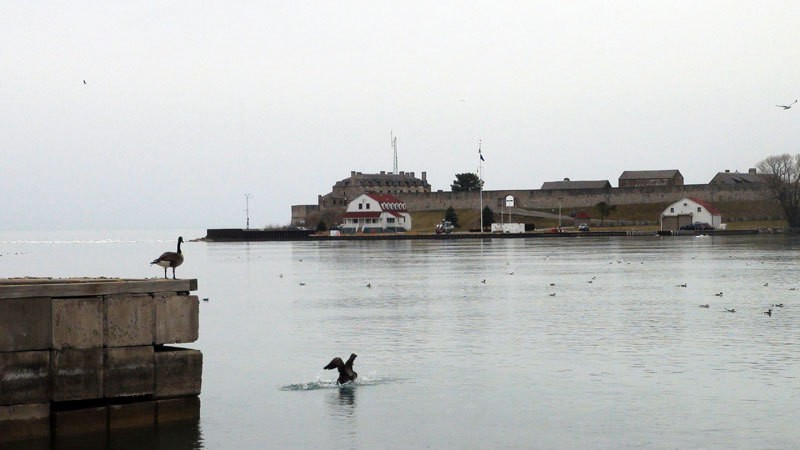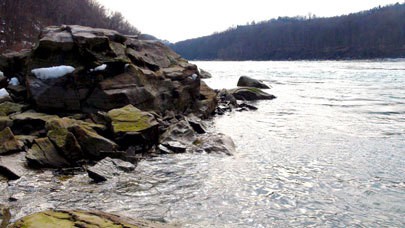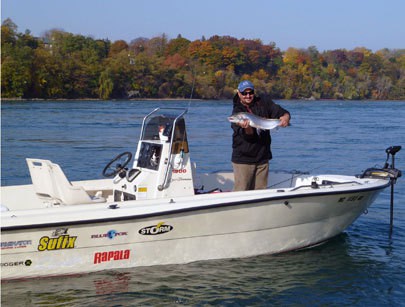Cross-Border Cooperation Leads to Cleaner Waterways

By Andrew Knochel
Cronkite Borderlands Initiative
NIAGARA FALLS, Ontario — Aldo Nava has been fishing in the Niagara River and in Lake Ontario since the 1970s. “Every year, the water looks clearer,” he said.
It should. The change was gradual, but the involved efforts were monumental. Over the last 40 years, the U.S. and Canada have each spent billions of dollars on cleaning up the Great Lakes region, including areas like the Niagara River, which was considered the most polluted waterway in North America in the 1970s.
New sewage treatment plants have been built, reducing the centuries-old practice of dumping industrial waste, city sewage and runoff into the rivers and the Great Lakes. Both countries enacted clean water acts, setting water quality standards, regulating the use of certain chemicals and requiring that discharges be permitted and monitored.
Environmental Protection Agency Public Affairs Officer Mike Basile has been working in western New York for more than 25 years. He has seen progress in reducing pollution through work in both countries.
“[T]he successes that we enjoy on both sides of the border, in cleaning the lake and the river, have all been realized because of our partnerships and because of our persistence on both sides using our environmental regulations,” said Basile.
In 1972, the U.S. and Canada signed the first Great Lakes Water Quality Agreement, vowing to work together to fix the mutual problems they recognized in shared waterways.
In 1987, the two countries modified the Great Lakes Water Quality Agreement, recognizing that there were locations throughout the Great Lakes region that had borne the brunt of the environmental damage — sites where beaches were closed, where fish had tumors or where the water was polluted to a level that it was difficult to treat for drinking or agricultural use.

The Niagara River at Devil's Hole State Park, N.Y. On average, 200,000 cubic feet of water per second flow down the river. A bi-lateral effort to clean up the river has been a success but new environmental threats have arisen. Photo by Andrew Knochel. |
The two countries created a program that called these sites “areas of concern,” and agreed to focus their efforts on reducing the effects of pollution in these areas. The goal was to make environmental conditions in these areas similar to those in the rest of the Great Lakes. The program identified 43 Areas of Concern: 26 in the U.S., 12 in Canada and five shared by both countries. Among these shared sites is the Niagara River, with its spectacular falls and troubled history.
“The tragedy of Niagara was that you have this available hydroelectric source in close proximity to the petroleum sites on Lake Erie, in Pennsylvania and up around Sarnia, and the combination of the two created these huge opportunities for petrochemical industries along the river,” said Mary Ellen Scanlon, Great Lakes adviser at the Ontario Ministry of the Environment.
The EPA and the New York State Department of Environmental Conservation spent more than $400 million, much of which was collected in fines from the former polluters, to remediate and contain these waste sites, ensuring that the toxic chemicals wouldn’t end up flowing into the river.
“We’re not looking for pristine outcomes,” said the EPA’s Great Lakes program manager, John Perrecone, referring to work in the Areas of Concern. “We’re taking a ‘D’ and ‘E’ student, and we’re tutoring him to become a ‘C’ student. And we’re telling him, ok you’re on your own now, study hard, be a good student, and you might get to be an ‘A’ student. But we’re not going to pay you for that. We’re going to pay to go from the ‘E’ to the ‘C.’”
Moving from an "E" to a "C," included dredging or capping riverbeds and harbor bottoms where sediments contained toxics, habitat restoration projects, new sewage treatment plants and cleaning up chemical dump sites on land.
U.S. and Canadian agencies managing the efforts were to measure progress in cleaning up 14 problems. These so-called “beneficial use impairments” were used to determine whether an area qualified it to be an Area of Concern. The range of problems included fish tumors or deformities, beach closings, restrictions on drinking water and loss of wildlife habitat. Ongoing monitoring measured progress by comparing current conditions to the original problems.
Today, the efforts gradually have resulted in cleaner beaches and more natural riverbanks. Native fish populations have even started reproduce. Five of the original 43 Areas of Concern have achieved all of their goals and have been delisted — two of them were locations on the U.S. side and three were on Canadian shores.
In September 2012, the two countries officially amended the Great Lakes Water Quality Agreement once again. The new agreement outlined further commitments to ecosystem restoration using cooperation and collaboration. The goal of the new agreement was to create a framework that would help the two countries “restore and maintain the chemical, physical and biological integrity of the Waters of the Great Lakes.”

Aldo Nava poses on his boat on the Niagara River, holding a steelhead trout he caught. Nava says the water in the river looks cleaner each year. Photo courtesy of Aldo Nava. |
The legal basis for the original agreement was a treaty the two countries signed in 1909, called the Boundary Waters Treaty. The treaty’s main focus was to prevent either country from using more than its fair share of water from shared rivers. During the negotiation, a clause was inserted that stated that boundary waters “shall not be polluted on either side.” The treaty created the International Joint Commission, a panel that would oversee responses to shared problems. The treaty established that three commissioners would be appointed from each country.
The new Great Lakes Water Quality Agreement reaffirms the countries’ commitments to restoring the Areas of Concern among other goals. The International Joint Commission also has a broader role — it looks at how to deal with many emerging problems facing the lakes. This includes invasive species, water level fluctuations and contaminants that weren’t considered a threat in the 1980s, such as pharmaceuticals.
The impact of aquatic invasive species has been one of the more difficult issues facing Great Lakes managers. So-called Asian carp, several species of fish that have disrupted rivers across the U.S., are seen as an enormous risk to the Great Lakes if they’re able to pass electric barriers in the Chicago River. The invasive fish could bring about major changes to the Great Lakes’ $7 billion sport and commercial fishing industries, competing with existing fish populations for food.
“We’re all concerned about Asian carp,” said Conrad de Barros, project manager at Ontario’s Ministry of the Environment, describing the joint efforts between Canadian provincial and federal governments in cooperation with the U.S. government. “We work efficiently across the border and share expertise, where we have expertise.”
He described an instance in 2009 when Asian carp DNA was detected downstream of the U.S. Army Corps of Engineers’ electric fences that were designed to keep the fish out of the Great Lakes. The Canadian Ministry of Fisheries and Oceans reviewed the U.S. response, offering their expertise on poison doses that would kill the invading fish.
The U.S. government has also spent millions to attempt to control sea lamprey populations, according to the Great Lakes Restoration Initiative’s website. The sea lamprey is a parasitic, eel-like fish that attaches itself to larger lake trout and salmon. A single sea lamprey can kill almost 40 pounds of fish during its parasitic phase, according to an Ontario invasive species awareness campaign.
Efforts to control existing invasive species and prevent introduction of other species were given a sense of urgency following the changes that occurred in the lakes after the waves of invasions by zebra and quagga mussels.
“The public doesn’t realize that the lakes don’t work the same way anymore,” Scanlon said. “It appears that zebra mussels filter out sediments and discharge phosphorous in a way that plants love. Younger people who are coming into Great Lakes management are managing different systems today.”
The public’s perception of problems in the lakes is different today, too, according to John Jackson of advocacy group Great Lakes United. He says it’s hard to get the public on both sides of the border to pay attention to the newer chemicals that have been found in the lakes, such as pharmaceuticals.
“The challenge of the Great Lakes is the visibility of the issues,” Jackson said. “There was a lot of attention to the Great Lakes back in the ’60s, when they were seeing all the dead fish coming up on shore or they saw all the gook. But as we made progress on cleaning up those more visible aspects, things look okay.”
The Great Lakes water quality management community has become increasingly concerned with chemicals in consumer products and pharmaceuticals. In 2009, the EPA and Environment Canada co-published a review of research around these chemicals. The review concluded that researchers were able to detect these substances at minute levels, but in many cases, there was no science to understand their impact.
The EPA’s Ted Smith said that the federal government is working to better understand the effect of these chemicals. “We’re developing more sophisticated tools to measure biological effects at various levels of biological organization,” Smith said. “But those tools are still under development.”
The International Joint Commission’s John Nevin, who is responsible for collecting public input, says that one issue which the public is very concerned about is dropping water levels in the Great Lakes, particularly in the Georgian Bay, on the east side of Lake Huron.
“[The level of] lakes Michigan and Huron is very low, and people especially around Georgian Bay are very concerned about low levels,” Nevin said. “You’ve got a lot of people who are hurting. The marinas are in trouble, tourism is down because the levels are low.”
The IJC commissioned a study in 2007 to guide policy in response to the dropping water levels. The study recommended tweaking the formula guiding water release from Lake Superior, and examined other potential responses, but didn’t recommend further actions, such as building new control structures at the south end of Lake Huron to raise the water level of lakes Michigan and Huron.
Nevin said the that the commission would make its own recommendation for responding to lower water levels to the two countries in 2013. He added that public comments on the study’s report showed strong support for measures that would restore the water levels in Lake Michigan and Lake Huron.
Members of the public who make their livings on the lakes like fisherman Aldo Nava are depending on the two governments to continue to make progress. Nava began his business taking tourists and locals fishing for salmon and lake trout in Lake Ontario and the Niagara River in 2002. Today, he has two boats, and books trips nearly year-round, as long as the weather is good.
He said the efforts have made a clear difference over the years.
“When I was young, you’d go to Lake Ontario, and you wouldn’t be able to see five feet into the water. The water would be brown, kind of a stained color,” Nava said. “Now everywhere I’ve been in the Great Lakes, the water’s clearer.”
Back to Top
